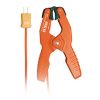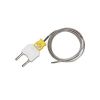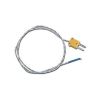Extech EA11A EasyView Type K Single Input Thermometer
The Extech EasyView Type K Single Input Thermometer simultaneoulsy displays current temperature and manually stores and recalls up to 150 readings.
Features
- Data hold function freezes reading on display
- Wide temperature range with 0.1/1 resolution
- Records max/min/avg readings for later recall
- Expedited repair and warranty service
- Lifetime technical support
- More
The Extech EasyView Type K Single Input Thermometer features a large dual LCD display that simultaneously displays current temperature and max/min/avg readings. The thermometer manually stores and recalls up to 150 readings for further analysis. The data hold function freezes readings on display, and the offset key is used for zero function to make relative measurements.
- Range: -58 to 1999°F (-50 to 1300°C)
- Accuracy: ±(0.3%rdg +2°F); ±(0.3%rdg +1°C)
- Resolution: 0.1°/1°
- Memory: manual store/recall up to 150 readings
- Dimensions: 5.9x2.8x1.3" (150x72x35mm)
- Weight: 8.3oz (235g)
- Warranty: 1 year
- (1) Thermometer
- (1) Built-in stand
- (1) Protective holster
- (1) Type K bead wire temperature probe
- (6) AAA batteries
In The News
Combating Water Insecurity in Saskatchewan with Real-Time Data
The prairies of Saskatchewan can be described as one of the least water-secure parts of Canada, making water quality monitoring essential for informed resource management in a region already facing water insecurity. While natural physical properties worsen some of the poor water quality conditions in the region, others are connected to land use. Having grown up spending summers on the shores of Lake Huron, Helen Baulch, an associate professor at the School of Environment and Sustainability at the University of Saskatchewan , has always been dedicated to the protection of water resources. Looking back fondly at her childhood playing along the shore, Baulch also recalls the invasion of quagga mussels during her teenage years and watching the lake change as a result.
Read MoreSeametrics Turbo Turbidity Logger: Boost your Turbidity Monitoring
The Seametrics Turbo Turbidity Logger is a self-cleaning turbidity sensor capable of internally logging over 260,000 data records. The sensor enables researchers, compliance officers, and contractors to monitor turbidity in various applications, from construction and dredging sites to wastewater effluent. Due to its narrow width, this device can be deployed in a range of areas, from small well spaces to rivers and streams. The stainless steel housing and built-in wiper allow the sensor to withstand long-term deployments and reduce the need for maintenance trips. The logger accurately records temperature and turbidity up to a depth of 50 meters.
Read MoreCollecting Data at the Top of the World: How Scientists Retrieve Glacial Ice Cores
A helicopter touches down in the small town of Sicuani, Peru, at an elevation of 11,644 feet. Earlier that day, a boxcar brought fuel, drills, food, and other equipment for a glacial expedition. The year is 1979, and glaciologist Lonnie Thompson is preparing to lead a team to the Quelccaya ice cap in hopes of becoming the first scientists to drill an ice core sample from this glacier. The only problem? The glacier is located at 19,000 feet in one of the most remote areas of the world. The helicopter takes off from the town, but the thin atmosphere at that elevation does not allow it to safely touch down on the ice– due to the aircraft’s weight, and it becomes unstable when the air is less dense.
Read More













